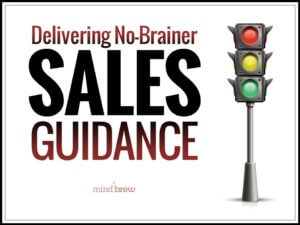When we look at the guidance that SellingBrew subscribers are providing to their sales teams these days, we are almost always impressed by the content. Sales Ops teams are knocking it out of the park when it comes to answering questions like
- Which prospects should I pursue next? (showing the prospects that have the best likelihood of converting)
- Which customers are showing signs of defection? (so the sales person has an opportunity to improve customer retention)
- Which other products/volume should this customer be buying? (so the salesperson can improve cross-sell and up-sell)
But the sales guidance we see tends to fall short in one key area: design.
We know, we know. You did not go to art school. You are far better at math and spreadsheets than at user interfaces and Photoshop.
We get it. But that doesn’t mean you are off the hook.
Most of the analytics and/or sales management tools that you are using to deliver guidance to the sales team have built-in capabilities for creating eye-catching visualizations. And even if you’re only using Excel, it has the ability to add graphs and color coding that makes the important information stand out.
Why does it matter?
You live and breathe numbers, so it’s easy for you to skim through a column on a spreadsheet and glean the important information. But salespeople don’t have the same mindset you do. Numbers just aren’t as meaningful for them.
If you want them to take action, you are going to have to draw them a picture.
And not just any picture. It needs to be a simple picture that tells a simple story that anyone can understand.
As analysts by nature, sales ops folks tend to want to put too much complexity into the guidance that they are delivering to the sales teams. We create dashboards that tell you absolutely everything you need to know about the sales numbers — but often they are missing the context that tells the salespeople what is most important.
Albert Einstein said, “The best design is the simplest one that works.” That’s particularly true for providing sales guidance.
You need to provide information that’s intuitive and self-contained. Avoid acronyms and provide clear labels and legends for any data. Use color coding, trend lines, and charts to make your point glaringly obvious. And when you think that the message is unmistakable, make it just a little bit simpler.
We cover these ideas in a lot more detail in the webinar on Delivering No-Brainer Sales Guidance. It also offers advice on how to deliver your guidance and types of guidance that other sales ops teams have found worked really well.
You might also want to check out How to Use Sales Analysis to Drive More Growth, which explains how to create some of the most common kinds of sales guidance.
Crunching the numbers to get the information that the sales team needs takes a lot of work. Don’t let that work go to waste by presenting your guidance in a way that doesn’t get your point across. By designing your reports and dashboards in a way that tells a simple, concise story, you have a much better chance of achieving your ultimate goal — getting the sales team to take action based on the information you provide.
And if you need some inspiration, check out the Data Is Beautiful subreddit to see how to present numbers in a meaningful way.













